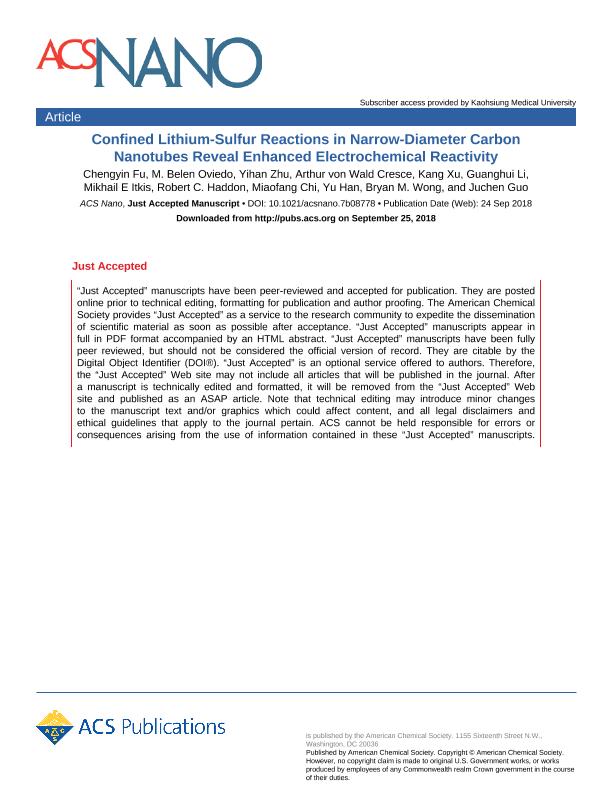Mostrar el registro sencillo del ítem
dc.contributor.author
Fu, Chengyin
dc.contributor.author
Oviedo, María Belén

dc.contributor.author
Zhu, Yihan
dc.contributor.author
von Wald Cresce, Arthur
dc.contributor.author
Xu, Kang
dc.contributor.author
Li, Guanghui
dc.contributor.author
Itkis, Mikhail E.
dc.contributor.author
Haddon, Robert C.
dc.contributor.author
Chi, Miaofang
dc.contributor.author
Han, Yu
dc.contributor.author
Wong, Bryan M.
dc.contributor.author
Guo, Juchen
dc.date.available
2019-11-11T14:14:13Z
dc.date.issued
2018-10
dc.identifier.citation
Fu, Chengyin; Oviedo, María Belén; Zhu, Yihan; von Wald Cresce, Arthur; Xu, Kang; et al.; Confined lithium–sulfur reactions in narrow-diameter carbon nanotubes reveal enhanced electrochemical reactivity; American Chemical Society; ACS Nano; 12; 10; 10-2018; 9775-9784
dc.identifier.issn
1936-0851
dc.identifier.uri
http://hdl.handle.net/11336/88431
dc.description.abstract
We demonstrate an unusual electrochemical reaction of sulfur with lithium upon encapsulation in narrow-diameter (subnanometer) single-walled carbon nanotubes (SWNTs). Our study provides mechanistic insight on the synergistic effects of sulfur confinement and Li+ ion solvation properties that culminate in a new mechanism of these sub-nanoscale-enabled reactions (which cannot be solely attributed to the lithiation-delithiation of conventional sulfur). Two types of SWNTs with distinct diameters, produced by electric arc (EA-SWNTs, average diameter 1.55 nm) or high-pressure carbon monoxide (HiPco-SWNTs, average diameter 1.0 nm), are investigated with two comparable electrolyte systems based on tetraethylene glycol dimethyl ether (TEGDME) and 1,4,7,10,13-pentaoxacyclopentadecane (15-crown-5). Electrochemical analyses indicate that a conventional solution-phase Li-S reaction occurs in EA-SWNTs, which can be attributed to the smaller solvated [Li(TEGDME)]+ and [Li(15-crown-5)]+ ions within the EA-SWNT diameter. In stark contrast, the Li-S confined in narrower diameter HiPco-SWNTs exhibits unusual electrochemical behavior that can be attributed to a solid-state reaction enabled by the smaller HiPco-SWNT diameter compared to the size of solvated Li+ ions. Our results of the electrochemical analyses are corroborated and supported with various spectroscopic analyses including operando Raman, X-ray photoelectron spectroscopy, and first-principles calculations from density functional theory. Taken together, our findings demonstrate that the controlled solid-state lithiation-delithiation of sulfur and an enhanced electrochemical reactivity can be achieved by sub-nanoscale encapsulation and one-dimensional confinement in narrow-diameter SWNTs.
dc.format
application/pdf
dc.language.iso
eng
dc.publisher
American Chemical Society

dc.rights
info:eu-repo/semantics/openAccess
dc.rights.uri
https://creativecommons.org/licenses/by-nc-sa/2.5/ar/
dc.subject
CONTROLLED SOLID-STATE REACTIONS
dc.subject
ELECTROCHEMICAL SYSTEMS
dc.subject
LITHIUM-SULFUR BATTERY
dc.subject
SINGLE-WALLED CARBON NANOTUBES
dc.subject
SUB-NANOSCALE CONFINED SULFUR
dc.subject.classification
Físico-Química, Ciencia de los Polímeros, Electroquímica

dc.subject.classification
Ciencias Químicas

dc.subject.classification
CIENCIAS NATURALES Y EXACTAS

dc.title
Confined lithium–sulfur reactions in narrow-diameter carbon nanotubes reveal enhanced electrochemical reactivity
dc.type
info:eu-repo/semantics/article
dc.type
info:ar-repo/semantics/artículo
dc.type
info:eu-repo/semantics/publishedVersion
dc.date.updated
2019-09-30T18:33:44Z
dc.identifier.eissn
1936-086X
dc.journal.volume
12
dc.journal.number
10
dc.journal.pagination
9775-9784
dc.journal.pais
Estados Unidos

dc.journal.ciudad
Washington
dc.description.fil
Fil: Fu, Chengyin. University Of California Riverside; Estados Unidos
dc.description.fil
Fil: Oviedo, María Belén. University Of California Riverside; Estados Unidos. Consejo Nacional de Investigaciones Científicas y Técnicas. Centro Científico Tecnológico Conicet - Córdoba. Instituto de Investigaciones en Físico-química de Córdoba. Universidad Nacional de Córdoba. Facultad de Ciencias Químicas. Instituto de Investigaciones en Físico-química de Córdoba; Argentina
dc.description.fil
Fil: Zhu, Yihan. Zhejiang University Of Technology; China
dc.description.fil
Fil: von Wald Cresce, Arthur. U. S. Army Research Laboratory; Estados Unidos
dc.description.fil
Fil: Xu, Kang. U. S. Army Research Laboratory; Estados Unidos
dc.description.fil
Fil: Li, Guanghui. University Of California Riverside; Estados Unidos
dc.description.fil
Fil: Itkis, Mikhail E.. University Of California Riverside; Estados Unidos
dc.description.fil
Fil: Haddon, Robert C.. University Of California Riverside; Estados Unidos
dc.description.fil
Fil: Chi, Miaofang. Oak Ridge National Laboratory; Estados Unidos
dc.description.fil
Fil: Han, Yu. King Abdullah University Of Science And Technology; Arabia Saudita
dc.description.fil
Fil: Wong, Bryan M.. University Of California Riverside; Estados Unidos
dc.description.fil
Fil: Guo, Juchen. University Of California Riverside; Estados Unidos
dc.journal.title
ACS Nano

dc.relation.alternativeid
info:eu-repo/semantics/altIdentifier/url/http://pubs.acs.org/doi/10.1021/acsnano.7b08778
dc.relation.alternativeid
info:eu-repo/semantics/altIdentifier/doi/http://dx.doi.org/10.1021/acsnano.7b08778
Archivos asociados
